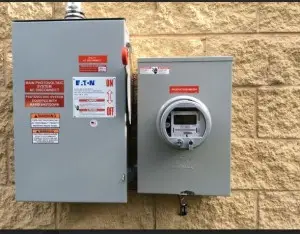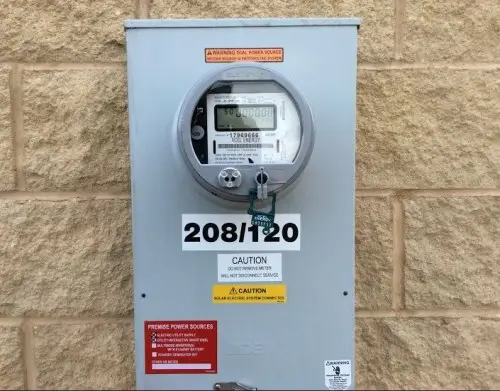When you install a solar energy system, you gain a few additional components on the side of your home or business. The Inverter, the AC Disconnect, the Production Meter, the Service Panel and the Bi-Directional meter all work together on your new system. Below are some commonly asked questions on how they work:
1. THE DC/AC INVERTER – What is the Pathway of Solar Electricity? How Does It Flow?
Like the electricity that flows from the power company through the grid and into your home by passing through the meter, electricity produced by your solar panels flows through the new inverter, inverting the direct current (DC) energy from the solar panels to the alternating current (AC) energy that we use in our homes and businesses.
2. THE AC DISCONNECT – How can I quickly shut down my system?
The AC disconnect is a pull down lever that immediately shuts off power flowing to the meters and the service panel in case of any emergency. This is a critical safety component of the overall system.

3. THE PRODUCTION METER – There is a second meter next to my original meter. What is it?
As electricity is changed from DC to AC through the inverter, it then passes through the production meter. Think of a production meter like an odometer on your car. It tallies the total amount of energy (kilowatt hours or kWh’s) produced by your system!
The production meter (or any revenue grade meter) allows the utility to track total electricity production for the purposes of calculating the “production-based incentive” (PBI) payments offered in some cases by the state or utility and/or so the utility can track the Renewable Energy Credits (REC’s). Readings from the production meter have no direct bearing on the amount you pay on your monthly utility bill.
Please Note: Not every solar system will have a production meter on site. They are only required in utility areas that offer incentive programs or that purchase REC’s.
4. THE SERVICE PANEL – How does the electricity produced by solar know where to go?
From the production meter, produced electricity flows to your service panel. Recall those moments when you’ve tripped a breaker and the lights go out or your microwave stops working. Then, you head to the basement or closet where the service panel lives and flip the switch back and everything starts working again.
Any electricity that you consume in your home– lights, appliances, hairdryer and other modern day devices that use each day –may directly use the electricity produced by solar when the sun is shining. Flowing through your existing service panel, solar produced electricity finds its way to where its most needed at any given time.
Note that in some cases, the solar circuitry, which are the wires that carry the electricity (through conduit) from the solar panels to the house or grid, gets directly connected to a tap can which sits on or near the bi-directional meter. This method bypasses the need to add a new circuit breaker into the service panel. Regardless of the method, electricity follows the path of least resistance and will always find its way to where it is needed most.
5. THE BI-DIRECTIONAL METER AND NET-METERING – When does electricity produced by solar go to the grid and not my home? Is this what they refer to as net-metering?
When you install solar, the original meter gets replaced with a bi-directional (or ‘Buy/Sell’) meter. This bi-directional meter is what makes net metering possible by measuring solar energy production as well as any electricity that you are also buying from the utility company . Net metering is the mechanism that ensures that your utility company will buy any excess power that you produce but you do not use at your site. In MN, this power is purchased at retail price.

6. Am I charged for any solar produced electricity that I consume directly in my home?
No. Energy (in kilowatt hours, or kWh) produced by your PV system that is consumed in your home, does NOT pass through the bi-directional meter. It flows straight from your PV system, through the production meter, and into your service panel to feed your outlets and appliances, etc. This is energy you do not buy from your utility or sell to them. Since this energy is directly consumed by your home, it is not explicitly included on your electric bill because it does not flow through the bi-directional meter at all!
A solar energy system provides a fantastic method to produce your own energy. Energy made at the same location where it is being used, is called on-site generation, or distributed generation (DG). With DG, there are no transmission losses. Solar energy is clean, safe and affordable! Go Solar!
Looking to add solar to your home or business? Contact us today! 612.888.9599


